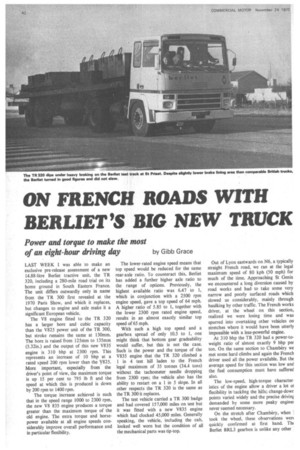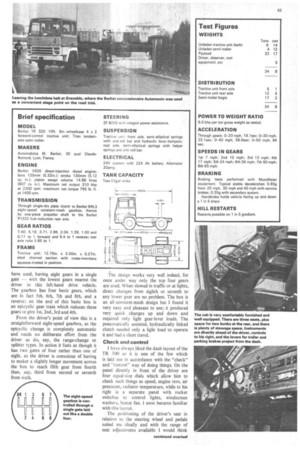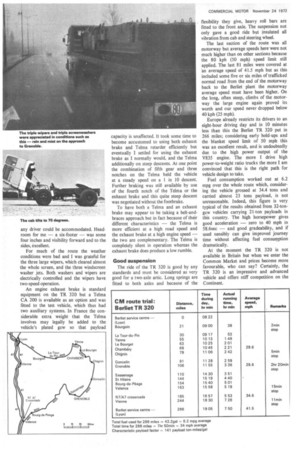ON FRENCH ROADS WITH BERLIET'S BIG NEW TRUCK
Page 38

Page 39

Page 40

If you've noticed an error in this article please click here to report it so we can fix it.
Power and torque to make the most
of an eight-hour driving day by Gibb Grace
LAST WEEK I was able to make an exclusive pre-release assessment of a new 14.88-litre Berliet tractive unit, the TR 320, including a 280-mile road trial on its home ground in South Eastern France. The unit differs outwardly only in name from the TR 300 first revealed at the 1970 Paris Show, and which it replaces, but changes to engine and axle make it a significant European vehicle.
The V8 engine fitted to the TR 320 has a larger bore and cubic capacity than the V825 power unit of the TR 300, but stroke remains the same at 130mm. The bore is raised from 125mm to 135mm (5.32in.) and the output of this new V835 engine is 310 bhp at 2300 rpm. This represents an increase of 10 bhp at •a rated speed 200 rpm lower than the Y825. More important, especially from the driver's point of view, the maximum torque is up 15 per cent to 795 lb ft and the speed at which this is produced is down by 200 rpm to 1400 rpm. The torque increase achieved is such that in the speed range 1000 to 2300 rpm, the new V8 835 engine produces a torque greater than the maximum torque of the old engine. The extra torque and horsepower available at all engine speeds considerably improve overall performance and in particular flexibility. The lower-rated engine speed means that top speed would be reduced for the same rear-axle ratio. To counteract this, Bernet has added a further higher axle ratio to the range of options. Previously, the highest available ratio was 6.47 to 1, which in conjunction with a 2500 rpm engine speed, gave a top speed of 64 mph. A higher ratio of 5.85 to 1, together with the lower 2300 rpm rated engine speed, results in an almost exactly similar top speed of 65 mph. With such a high top speed and a gearbox spread of only 10.5 to 1, one might think that bottom gear gradeability would suffer, but this is not the case. Such is the power and the torque of the V835 engine that the TR 320 climbed a 1 in 4 test hill laden to the French legal maximum of 35 tonnes (34.4 tons) without the tachometer needle dropping from 2300 rpm; the vehicle also has the ability to restart on a 1 in 5 slope. In all other respects the TR 320 is the same as the TR 300 it replaces.
The test vehicle carried a TR 300 badge and had covered 157,000 miles on test but it was fitted with a new V835 engine which had clocked 45,000 miles. Generally speaking, the vehicle, including the cab, looked well worn but the condition of all the mechanical parts was tip-top. Out of Lyon eastwards on N6, a typically straight French road, we ran at the legal maximum speed of 80 kph (50 mph) for much of the time. Approaching St Genix we encountered a long diversion caused by road works and had to take some very narrow and poorly surfaced roads which slowed us considerably, mainly through baulking by other traffic. The French works driver, at the wheel on this section, realized we were losing time and was spurred into overtaking other vehicles on stretches where it would have been utterly impossible with a less-powerful engine.
At 310 bhp the TR 320 had a power-toweight ratio of almost exactly 9 bhp per ton. On the same section to Chambery we met some hard climbs and again the French driver used all the power available. But the average speed for this section was low and the fuel consumption must have suffered also.
The low-speed, high-torque characteristics of the engine allow a driver a lot ol flecibility in tackling the hills; change-dowr points varied widely and the precise drivinE demanded by some more peaky engine: never seemed necessary.
On the stretch after Charnbery, when 1 took the wheel, these observations wert quickly confirmed at first hand. Tla Berliet BRL3 gearbox is unlike any other have used, having eight gears in a single gate with the lowest gears nearest the driver in this left-hand drive vehicle. The gearbox has four basic gears, which are in fact 5th, 6th, 7th and 8th, and a reverse: on the end of this basic box is an epicyclic gear train which reduces these gears to give 1st, 2nd, 3rd and 4th.
From the driver's point of view this is a straightforward eight-speed gearbox, as the epicyclic change is completely automatic and needs no deliberate effort from the driver as do, say, the range-change or, splitter types. In action it feels as though it has two gates of four rather than one of eight, as the driver is conscious of having to maker a slightly longer movement across the box to reach fifth gear from fourth than, say, third from second or seventh from sixth.
The design works very well indeed, for once under way only the top four gears are used. When slowed in traffic or at lights, direct changes from eighth or seventh to any lower gear are no problem. The box is an all-constant-mesh design but I found it very easy and pleasant to use; it produced very quick changes up and down and required only light gear-lever loads. The pneumatically assisted, hydraulically linked clutch needed only a light load to operate it and had a short travel.
Check and control
I have always liked the dash layout of the 'FR 300 as it is one of the few which is laid out in accordance with the "check" and "control" way of doing things. On the panel directly in front of the driver are four equal-size dials which allow him to check such things as speed, engine revs, air pressures, radiator temperature, while to his right is a separate panel with rocker switches to control lights, windscreen washers, heater fan. I soon became familiar with this layout.
The positioning of the driver's seat in relation to the steering wheel and pedals suited me ideally and with the range of seat adjustments available I would think
any driver could be accommodated. Headroom for me — a six-footer — was some four inches and visibility forward and to the sides, excellent.
For much of the route the weather conditions were bad and I was grateful for the three large wipers, which cleared almost the whole screen, and the three windscreen washer jets. Both washers and wipers are electrically controlled and the wipers have two-speed operation.
An engine exhaust brake is standard equipment on the TR 320 but a Telma CA 200 is available as an option and was fitted to the test vehicle, which thus had two auxiliary systems. In France the considerable extra weight that the Telma involves may legally be added to the vehicle's plated gew so that payload capacity is unaffected. It took some time to become accustomed to using both exhaust brake and Telma retarder efficiently but eventually I settled for using the exhaust brake as I normally would, and the Telma additionally on steep descents. At one point the combination of fifth gear and three notches on the Telma held the vehicle at a steady speed on a 1 in 10 descent. Further braking was still available by use of the fourth notch of the Telma or the exhaust brake and this quite steep descent was negotiated without the footbrake.
To have both a Telma and an exhaust brake may appear to be taking a belt-andbraces approach but in fact because of their different characteristics — the Telma is more efficient at a high road speed and the exhaust brake at a high engine speed — the two are complementary. The Telma is completely silent in operation whereas the exhaust brake does produce a low rumble.
Good suspension The ride of the TR 320 is good by any standards and must be considered as very good for a two-axle artic. Long springs are fitted to both axles and because of the flexibility they give, heavy roll bars are fitted to the front axle. The suspension not only gave a good ride but insulated all vibration from cab and steering wheel.
The last section of the route was all motorway but average speeds here.were not much higher than on other sections because the 80 kph (50 mph) speed limit still applied. The last 81 miles were covered at an average speed of 41.5 mph but as this included some five or six miles of trafficked normal road from the end of the motorway back to the Berliet plant the motorway average speed must have been higher. On the long, often steep, climbs of the motorway the large engine again proved its worth and our speed never dropped below 40 kph (25 mph).
Europe already restricts its drivers to an eight-hour driving day and in 10 minutes less than this the Berliet TR 320 put in 266 miles; considering early hold-ups and the blanket speed limit of 50 mph this was an excellent result, and is undoubtedly due to the high power output of the V835 engine. The more I drive high power-to-weight ratio trucks the more I am convinced that this is the right path for vehicle design to take.
Fuel consumption worked out at 6.2 mpg over the whole route which, considering the vehicle grossed at 34.4 tons and carried almost 23 tons payload, is not unreasonable. Indeed, this figure is very typical of the results obtained from 32-tongcw vehicles carrying 21-ton payloads in this country. The high horsepower gives good acceleration — zero to 40 mph in 58.6sec — and good gradeability, and if used sensibly can give improved journey time without affecting fuel consumption dramatically.
At the moment the TR 320 is not available in Britain but when we enter the Common Market and prices become more favourable, who can say? Certainly, the TR 320 is an impressive and advanced vehicle and offers stiff competition on the Continent.












































































































